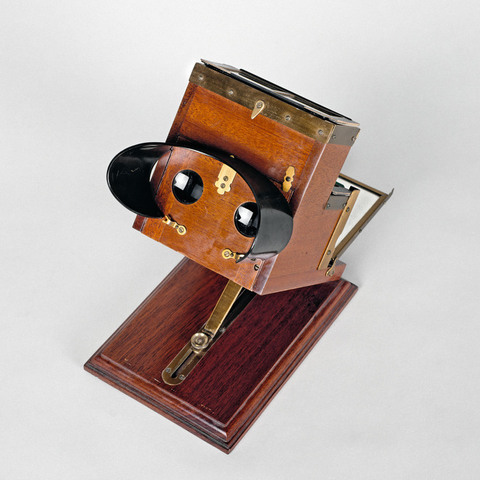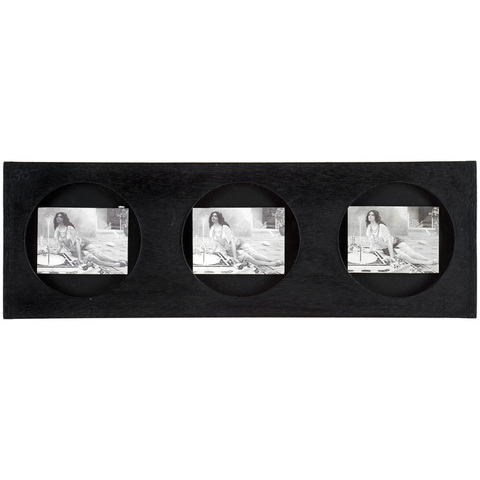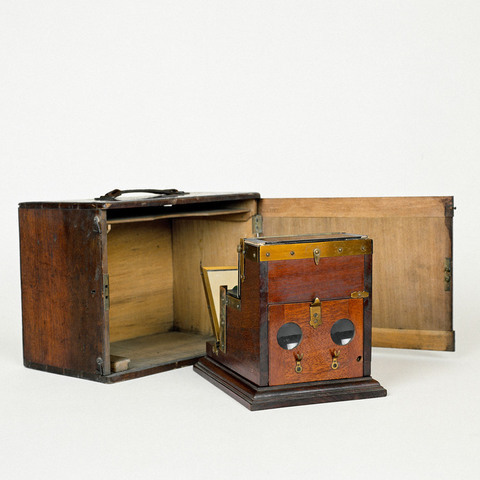Stéréoscope à plaques photographiques en couleur (système trichrome)
Fiche détaillée
Type de l'appareil
boîtier inclinable et réglable en acajou verni ; visière ; deux lentilles ; trois filtres en verre (un filtre horizontal rouge, un filtre horizontal bleu, un filtre vertical vert, chacun recevant l'une des trois plaques stéréoscopiques en verre) ; miroir orientable ; verre dépoli 13 x 26 cm
Auteurs
Ives Frederic Eugene
Pennsylvanie, Philadelphie, 1324 Chesnut Street
Fabricants
Photochromoscope Syndicate Limited
Londres, 121 Shaftesbury Avenue W.C.
Frederic Eugene Ives
Pennsylvanie, Philadelphie, 1324 Chesnut Street
Utilisateurs
Ives Frederic Eugene
Pennsylvanie, Philadelphie, 1324 Chesnut Street
Distributeurs
Photochromoscope Syndicate Limited
Londres, 121 Shaftesbury Avenue W.C.
Sujet du modèle
Informations non disponibles
Objectif
2 lentilles 3 cm Ø
Taille de l'objet
Ouvert :
Longueur : 31 cm
Largeur : 16.5 cm
Hauteur : 26.5 cm
Fermé :
Longueur : 29 cm
Largeur : 16.5 cm
Hauteur : 17.5 cm
Diamètre :
Informations non disponibles
Taille de la boîte de transport
Longueur : 18 cm
Largeur : 28.5 cm
Hauteur : 22 cm
Remarques
Marque : "The "KROMSKOP" Ives's Patent, The Photochromoscope Syndicate Ltd, Holbein House, 121 Shaftesbury Ave London W.C."
Deux exemplaires identiques (voir AP-95- 1286), collection Will Day. Mais celui-ci possède sa visière. Voir aussi le projecteur trichrome de Ives (AP-95- 1223).
Frederic Eugene Ives (17 février 1856, Litchfield, Connecticut - 27 mai 1937, Philadelphie).
Un exemplaire monoscopique, le "Junior Kromskop", a aussi été commercialisé.
"The Kromskop is an optical instrument which accomplishes for light and color what the Phonograph accomplishes for sound and the Kinetoscope for motion. Although it does not produce fixed colored photographs, it is a veritable realization of color photography to the extent of bringing before the eyes, by a simple and practical process, a photographic image in the natural colors which is far more perfect and realistic than any colored picture on paper could possibly be, because it is perfectly free from surface texture and reflections, and is seen without distracting surroundings, and in solid relief, exactly as the object itself is seen by the eyes. The Kromoscop system of color photography is based upon the fact that all the varied hues in nature are physiologically equivalent to mixtures of three simple spectrum colors, red, green, and blue-violet. The Kromskop photograph consist of three stereoscopic pairs of images, similar in appearance to ordinary uncolored lantern slides, but which, by differences in their light and shade, represent the distribution and proportions of the respective "primary" colors in the object photographed. [...] The Kromskop color record, unlike most colored pictures, is absolutely permanent, the same to day and fifty or even hundreds of years hence, and it is only necessary, in order to reproduce the colors which it represents, to illuminate the uncolored photographs, each by its appropriate colored light, and to optically superpose and blend them together, so that they are seen as a single image. This is accomplished in the Kromskop so perfectly that all suggestion of photography vanishes, and the very object photographed, be it flowers, fruit, portrait, landscape, or work of art, appears to stand before the eyes. [...] When using the Kromskop by day it should be placed close to a window, so that the light from the sky mal fall directly upon it, without the interference of sash bars, blinds-cords or other instructions. It must be remembered that the actual colors of the original object are only seen when all three sections of the triple Kromogram are evenly and equally illuminated. [...] When the Kromskop has been placed on a small table near a window facing a sufficient expanse of sky, the external mirror (the position of which is regulated by a screw) should be released. The body of the instrument should then be inclined towards the light until an even field of nearly white light is seen through the lenses, in which position it may be secured firmly by the screw which travels in the slot beneath. [...] When the Kromskop is set to give an even white field of light to persons having normal color vision, about one male in twenty, and a smaller percentage of females, will see it more or less blue-green, owing to partial red color-blindness ; and this will be true even though the color-blindness may not be sufficient to have been discovered under ordinary circumstances, the mixture of spectrum red, green, and blue in the Kromskop forming a most sensitive test. To a partially green color blind person, the same field will appear pink or magenta tinted ; but green color blindness is very rare. It is of the first importance that the Kromogram should always be place correctly in the Kromskop. If placed upside-down, or reversed, the result would be confusion" (Frederic Eugene Ives, Krômskôp Color Photography, Londres, Photochromoscope Syndicate LTD, 1898).
"J'applique le terme Photochromoscope à un instrument destiné à fondre ensemble, par des procédés optiques, une série d'images représentant le même sujet, qui constituent ce que je dénomme un Chromogramme et qui sont vues à travers des verres de différentes couleurs ou sous des lumières différemment colorées. Un Chromogramme se compose d'une série de positifs photographiques (de préférence au nombre de trois) sur verre ou autre matière transparente, obtenus à l'aide d'un ou de plusieurs négatifs comprenant une série correspondante d'images du même sujet. Lorsqu'il y a trois images, l'une d'elles doit être obtenue par des rayons lumineux en proportion telle (ou approximativement) qu'ils provoquent la sensation ou impression fondementale du rouge ; une autre image doit être obtenue par des rayons lumineux en proportion telle qu'ils provoquent la sensation ou l'impression fondamentale du vert ; & la troisième par des rayons lumineux qu'ils provoquent la sensation ou impression fondamentale du bleu ou du violet. Des rayons lumineux passant à travers trois de ces images et à travers des écrans de couleurs convenablement choisi reproduiront, s'ils sont dirigés de façon à superposer exactement les trois images, les couleurs naturelles de l'objet photographié" (Frederic Eugene Ives, BF n° 243 727, déposé le 18 décembre 1894, délivré le 2 avril 1895, "instrument permettant de voir les images en couleurs dit Photochromoscope").
"Le Kromskope. Cet appareil est destiné à recevoir les Chromogrammes et donner à l'oeil le spectacle merveilleux de la reproduction des couleurs naturelles de l'objet ou de la personne photographiée et de plus le relief de la nature par la vision stéréoscopique. Prix 150 francs avec 4 Chromogrammes. Chaque vue en plus 7 francs" (Maison fondée en 1860, Grande manufacture d'instruments de précision, Clément & Gilmer Ingénieurs-Constructeurs, Catalogue n° 22, Paris, Clément & Gilmer, s.d. [c. 1902], p. 175-177). A noter que dans ce catalogue, 50 "Chromogrammes" sont proposés à la vente.
Bibliographie
Frederic Eugene Ives, Krômskôp Color Photography, Londres, Photochromoscope Syndicate LTD, 1898.
Maison fondée en 1860, Grande manufacture d'instruments de précision, Clément & Gilmer Ingénieurs-Constructeurs, Catalogue n° 22, Paris, Clément & Gilmer, s.d. [c. 1902], p. 175-177.


